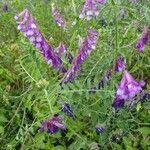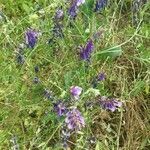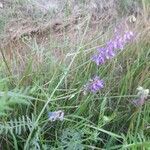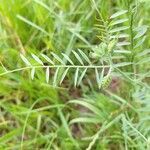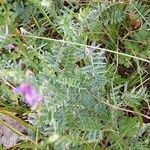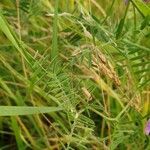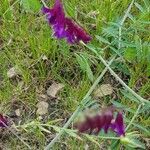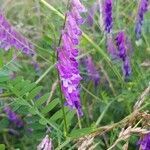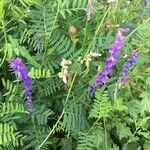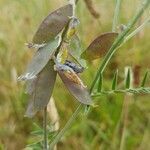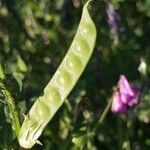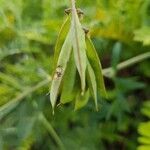Scrambling perennial; stems ± glabrous or sparsely clothed in appressed hairs. Lvs usually moderately clothed in appressed hairs above and below; tendrils branched at least in upper lvs; leaflets in 5-12 pairs, sometimes alternate, ovate-oblong or narrowly elliptic, (5)-12-20 mm long; stipules entire or with 1-(2), narrow, adaxial, basal lobes. Infl. > lvs, (6)-10-40-flowered. Peduncle much > fls. Pedicel c. 2 mm long. Calyx strongly gibbous at base, ± glabrous or sparsely hairy; calyx teeth very unequal; lower < tube. Corolla violet, purple or bluish lilac, (13)-14-18 mm long; limb of standard 1/2 as long as claw. Pod glabrous, brown, 3-8-seeded, 20-35 mm long; seeds dark greenish brown or mottled, 3-4 mm diam.; hilum 1/9-⅙ of circumference.
Annual or biennial to 1 m, the stems spreading-villous, especially upwards; lfls usually 5–10 pairs, narrowly oblong to lance-linear, 1–2.5 cm; racemes long-peduncled, dense, secund, with 10–40 fls; cal irregular, villous, the tube 2.3–4 mm, very gibbous, the pedicel apparently ventral; upper lobes linear-triangular, 0.8–1.5 mm; lateral and lower lobes linear above a triangular base, the lowest 2–5 mm, long-villous; cor slender, 12–20 mm, the spreading blade of the standard less than half as long as the claw; fr 2–3 cm, glabrous; 2n=14. Native of Europe, intr. in fields, roadsides, and waste places throughout most of the U.S. and s. Can. June–Aug.
Annual or biennial herbaceous vine, up to 1.3 m high; white-villous. Leaves with rachis terminating in a ramified, prehensile tendril. Leaflets 8-20, entire, oblong-ovate, 8-35 x 1-10 mm, apex mucronulate. Stipules inconspicuous, entire. Inflorescences of elongate racemes, usually longer than subtending leaf; flowers 5-40, closely spaced. Flowers bluish purple to pink or white. Calyx ± half as long as standard petal, gibbous at base. Petals: standard 12-20 mm long. Flowering time Sept.-Apr. Pod stipitate, 20-40 mm long, dark to light straw-coloured, oblong, obliquely short acuminate at both ends. Seeds 4 or 5, spherical to sublenticular.
A climbing herb. It is hairy and an annual plant. It has branched tendrils. It can grow 2 m long. The stems have long hairs. The stipules are not lobed. The leaves have 4-12 pairs of narrow leaflets. The groups of flowers are longer than the leaves. The flowers are violet, purple or blue. They are 10-20 mm long. There are 10-30 flowers in a raceme. The fruit are pods 20-40 mm long and brown. The seeds are round and black and 3-4 mm across.
